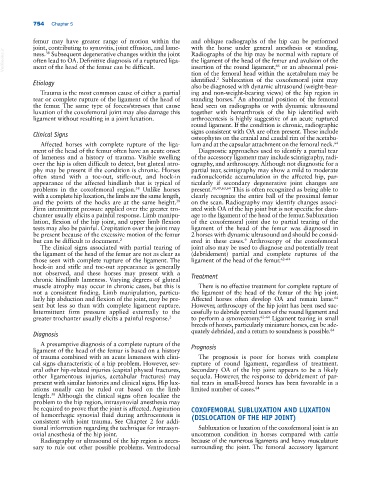Page 788 - Adams and Stashak's Lameness in Horses, 7th Edition
P. 788
754 Chapter 5
femur may have greater range of motion within the and oblique radiographs of the hip can be performed
joint, contributing to synovitis, joint effusion, and lame- with the horse under general anesthesia or standing.
VetBooks.ir often lead to OA. Definitive diagnosis of a ruptured liga- the ligament of the head of the femur and avulsion of the
Radiographs of the hip may be normal with rupture of
ness. Subsequent degenerative changes within the joint
38
insertion of the round ligament, or an abnormal posi-
ment of the head of the femur can be difficult.
66
tion of the femoral head within the acetabulum may be
identified. Subluxation of the coxofemoral joint may
2
Etiology
also be diagnosed with dynamic ultrasound (weight‐bear-
Trauma is the most common cause of either a partial ing and non‐weight‐bearing views) of the hip region in
9
tear or complete rupture of the ligament of the head of standing horses. An abnormal position of the femoral
the femur. The same type of forces/stresses that cause head seen on radiographs or with dynamic ultrasound
luxation of the coxofemoral joint may also damage this together with hemarthrosis of the hip identified with
ligament without resulting in a joint luxation. arthrocentesis is highly suggestive of an acute ruptured
round ligament. If the condition is chronic, radiographic
signs consistent with OA are often present. These include
Clinical Signs
osteophytes on the cranial and caudal rim of the acetabu-
Affected horses with complete rupture of the liga- lum and at the capsular attachment on the femoral neck. 64
ment of the head of the femur often have an acute onset Diagnostic approaches used to identify a partial tear
of lameness and a history of trauma. Visible swelling of the accessory ligament may include scintigraphy, radi-
over the hip is often difficult to detect, but gluteal atro- ography, and arthroscopy. Although not diagnostic for a
phy may be present if the condition is chronic. Horses partial tear, scintigraphy may show a mild to moderate
often stand with a toe‐out, stifle‐out, and hock‐in radionucleotide accumulation in the affected hip, par-
appearance of the affected hindlimb that is typical of ticularly if secondary degenerative joint changes are
38
problems in the coxofemoral region. Unlike horses present. 38,49,63,64 This is often recognized as being able to
with a complete hip luxation, the limbs are the same length, clearly recognize the entire ball of the proximal femur
and the points of the hocks are at the same height. on the scan. Radiography may identify changes associ-
38
Firm intermittent pressure applied over the greater tro- ated with OA of the hip joint but is not specific for dam-
chanter usually elicits a painful response. Limb manipu- age to the ligament of the head of the femur. Subluxation
lation, flexion of the hip joint, and upper limb flexion of the coxofemoral joint due to partial tearing of the
tests may also be painful. Crepitation over the joint may ligament of the head of the femur was diagnosed in
be present because of the excessive motion of the femur 2 horses with dynamic ultrasound and should be consid-
9
but can be difficult to document. 2 ered in these cases. Arthroscopy of the coxofemoral
The clinical signs associated with partial tearing of joint also may be used to diagnose and potentially treat
the ligament of the head of the femur are not as clear as (debridement) partial and complete ruptures of the
those seen with complete rupture of the ligament. The ligament of the head of the femur. 62–64
hock‐in and stifle and toe‐out appearance is generally
not observed, and these horses may present with a
chronic hindlimb lameness. Varying degrees of gluteal Treatment
muscle atrophy may occur in chronic cases, but this is There is no effective treatment for complete rupture of
not a consistent finding. Limb manipulation, particu- the ligament of the head of the femur of the hip joint.
larly hip abduction and flexion of the joint, may be pre- Affected horses often develop OA and remain lame.
64
sent but less so than with complete ligament rupture. However, arthroscopy of the hip joint has been used suc-
Intermittent firm pressure applied externally to the cessfully to debride partial tears of the round ligament and
greater trochanter usually elicits a painful response. 2 to perform a synovectomy. 62–64 Ligament tearing in small
breeds of horses, particularly miniature horses, can be ade-
Diagnosis quately debrided, and a return to soundness is possible. 64
A presumptive diagnosis of a complete rupture of the
ligament of the head of the femur is based on a history Prognosis
of trauma combined with an acute lameness with clini- The prognosis is poor for horses with complete
cal signs characteristic of a hip problem. However, sev- rupture of round ligament, regardless of treatment.
eral other hip‐related injuries (capital physeal fractures, Secondary OA of the hip joint appears to be a likely
other ligamentous injuries, acetabular fractures) may sequela. However, the response to debridement of par-
present with similar histories and clinical signs. Hip lux- tial tears in small‐breed horses has been favorable in a
ations usually can be ruled out based on the limb limited number of cases. 64
length. Although the clinical signs often localize the
38
problem to the hip region, intrasynovial anesthesia may
be required to prove that the joint is affected. Aspiration COXOFEMORAL SUBLUXATION AND LUXATION
of hemorrhagic synovial fluid during arthrocentesis is (DISLOCATION OF THE HIP JOINT)
consistent with joint trauma. See Chapter 2 for addi-
tional information regarding the technique for intrasyn- Subluxation or luxation of the coxofemoral joint is an
ovial anesthesia of the hip joint. uncommon condition in horses compared with cattle
Radiography or ultrasound of the hip region is neces- because of the numerous ligaments and heavy musculature
sary to rule out other possible problems. Ventrodorsal surrounding the joint. The femoral accessory ligament

